
Mary, Queen of the World Cathedral or in full Mary, Queen of the World and St. James the Great Cathedral is a minor basilica in Montreal, Quebec, Canada, and the seat of the Roman Catholic archdiocese of Montreal. It is the third largest church in Quebec after Saint Joseph's Oratory and the Basilica of Sainte-Anne-de-Beaupré east of Quebec City. The building is 101 m (333 ft) in length, 46 m (150 ft) in width, and a maximum height of 77 m (252 ft) at the cupola, the diameter of which is 23 m (75 ft).
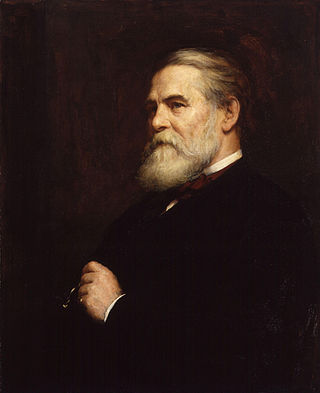
John Loughborough Pearson was a British Gothic Revival architect renowned for his work on churches and cathedrals. Pearson revived and practised largely the art of vaulting, and acquired in it a proficiency unrivalled in his generation. He worked on at least 210 ecclesiastical buildings in England alone in a career spanning 54 years.

The Cathedral Basilica of Our Lady of Peace is the mother church of the Diocese of Honolulu and houses the cathedra of the Bishop of Honolulu in Honolulu, Hawaiʻi. It is located at the north end of Fort Street Mall in downtown Honolulu. Another cathedra was installed in the Co-Cathedral of Saint Theresa of the Child Jesus, also serving the diocese.

Sacred Heart Cathedral, located in Davenport, Iowa, United States, is a Catholic cathedral and a parish church in the Diocese of Davenport. The cathedral is located on a bluff overlooking the Mississippi River to the east of Downtown Davenport. It is listed on the National Register of Historic Places as part of the Sacred Heart Roman Catholic Cathedral Complex. This designation includes the church building, rectory, and the former convent, which was torn down in 2012. The cathedral is adjacent to the Cork Hill Historic District, also on the National Register. Its location on Cork Hill, a section of the city settled by Irish immigrants, gives the cathedral its nickname Cork Hill Cathedral.

St Etheldreda's Church is a Roman Catholic church in Ely Place, off Charterhouse Street in Holborn, London. The building is one of only two surviving in London from the reign of Edward I, and dates from between 1250 and 1290. It is dedicated to Æthelthryth, or Etheldreda, the Anglo-Saxon saint who founded the monastery at Ely in 673. It was the chapel of the London residence of the Bishops of Ely.

The Cathedral of St. Mary located in St. Cloud, Minnesota, United States, is the cathedral and parish church in the Catholic Diocese of St. Cloud. The St. Cloud Diocese serves Central Minnesota and a Catholic population of about 150,000.
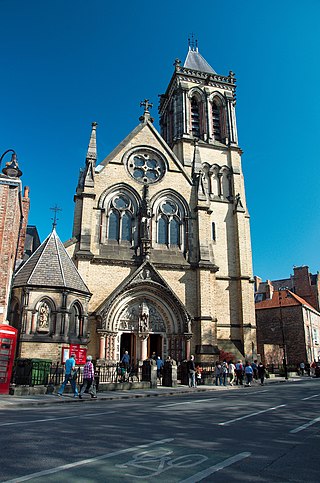
George Goldie was an English ecclesiastical architect who specialised in Roman Catholic churches.
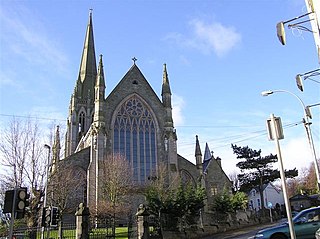
St Eugene's Cathedral is the Roman Catholic cathedral located in Derry, Northern Ireland. It is the "Mother Church" for the Roman Catholic Diocese of Derry, as well as the parish Church of the parish of Templemore.

J. W. Walker & Sons Ltd is a British firm of organ builders established in 1828 by Joseph William Walker in London. Walker organs were popular additions to churches during the Gothic Revival era of church building and restoration in Victorian Britain, and instruments built by Walker are found in many churches around the UK and in other countries. The firm continues to build organs today.

St Mary of the Angels is a Catholic church on the corner of Boulcott Street and O'Reily Avenue in Wellington, New Zealand. It is the parish church for Wellington Central and one of the major churches of the city. The Marist Fathers have provided clergy for St Mary of the Angels since 1874 in succession to its founding and long-serving parish priest, the Capuchin Franciscan, Father Jeremiah O'Reily. The church was used by Archbishop O'Shea as his pro-cathedral (1936–1954). It was the site of the funeral of Suzanne Aubert in 1926 and is well known for its church music tradition.
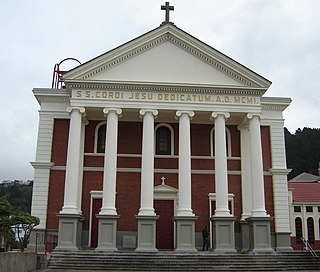
The Metropolitan Cathedral of the Sacred Heart and of Saint Mary His Mother, better known as Sacred Heart Cathedral, is a Roman Catholic cathedral on Hill Street, Wellington, New Zealand. It is the parish church of the Thorndon Catholic parish and the cathedral of the Archbishop of Wellington. The New Zealand Parliament is a close neighbour of the cathedral. However, the Thorndon Catholic parish predates that institution. The cathedral is part of a Catholic precinct which includes St Mary's College; Sacred Heart Cathedral School; St Mary's Convent, the motherhouse of the Sisters of Mercy in Wellington; the Catholic Centre, in which Catholic administration is located; and Viard House, which is both the cathedral parish presbytery and the residence of the archbishop.

Holy Cross Church is a Roman Catholic church located at 329 West 42nd Street between Eighth and Ninth Avenues in the Hell's Kitchen neighborhood of Manhattan, New York City, near Times Square and across the street from the Port Authority Bus Terminal.
The Sardinian Embassy Chapel was an important Catholic church and embassy chapel attached to the Embassy of the Kingdom of Sardinia in the Lincoln's Inn area of London. It was demolished in 1909.
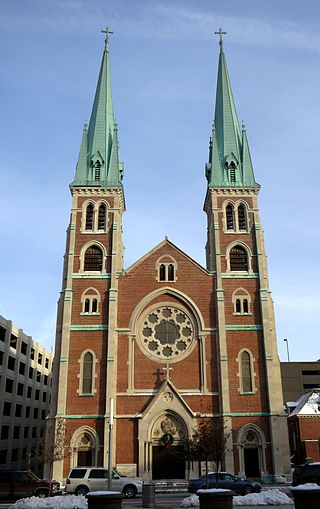
Saint John the Evangelist Catholic Church is a Roman Catholic parish of the Archdiocese of Indianapolis in Indianapolis, Indiana, United States. The parish's origins date to 1837, when it was first named Holy Cross parish. In 1850 it was renamed Saint John the Evangelist parish, and is the oldest Catholic parish in the city and in Marion County, Indiana. Considered the mother of the Catholic parishes in Indianapolis, it played an important role in development of the Catholic Church in the city. Saint John's Church served as the pro-cathedral of the diocese from 1878 until 1906; its rectory served as the bishop's residence and chancery from 1878 until 1892. In 1900 the church served as the site of first episcopal consecration held in Indianapolis.

The Parish Church of St Mary and St Augustine in Stamford, Lincolnshire, England, is home to a congregation of the Roman Catholic Diocese of Nottingham. St Augustine's was designed in a "robust High Victorian Early English" style by George Goldie, one of the foremost Catholic architects in England in the nineteenth century. It was built over 1862-64 and while much of its Victorian interior was stripped out in the middle decades of the twentieth century, it still retains some furnishings and fittings of distinction.

The Embassy of Spain in London is the diplomatic mission of Spain in the United Kingdom. The embassy is located at 24 Belgrave Square in the Belgravia area of London. Spain also maintains a Consulate General at 20 Draycott Place in Chelsea, a Defence Office at 3 Hans Crescent in Knightsbridge, an Education, Employment & Social Affairs Office at 20 Peel Street in Holland Park, and an Economic & Commercial Section at 66 Chiltern Street in Marylebone.

The Church of Our Lady of the Assumption and St Gregory is a Catholic church on Warwick Street, Westminster. It was formerly known as the Royal Bavarian Chapel, because like several Catholic churches in London it originated as a chapel within a foreign embassy. It was built between 1789 and 1790 to the designs of Joseph Bonomi the Elder. The only surviving eighteenth-century Catholic chapel in London, it is a Grade II* listed building. The parish is now operated by the Personal Ordinariate of Our Lady of Walsingham, the British personal ordinariate for the Anglican Use within the Catholic Church.

St Mary's Church is a Roman Catholic parish church in the city centre of Sunderland, Tyne and Wear, situated on the corner of Bridge Street and St Mary's Way. It is a Grade II listed building, designed by Ignatius Bonomi. Built from 1830 to 1835, and is the earliest Gothic revival church surviving in Sunderland.

St Thomas of Canterbury Church is a Roman Catholic Parish church in Canterbury, Kent, England. It was built from 1874 to 1875 in the Gothic Revival style. It is situated on the corner of Burgate and Canterbury Lane, west of Lower Bridge Street, opposite the grounds of Canterbury Cathedral in the centre of the city. It is the only Roman Catholic church in Canterbury, built on the site of a medieval church ; the old St Mary Magdalen’s Tower was retained. The church contains relics of Thomas Becket.
An embassy chapel is a place of worship within a foreign mission. Historically they have sometimes acted as clandestine churches, tolerated by the authorities to operate discreetly. Since embassies are exempt from the host country's laws, a form of extraterritoriality, these chapels were able to provide services to prohibited and persecuted religious groups. For example, Catholic embassy chapels in Great Britain provided services while Catholicism was banned under the Penal Laws. A similar role was filled for Protestants by the Prussian embassy chapel in Rome, where Protestantism was unlawful until 1871. Upon laws granting freedom of religion, these embassy chapels have often become regularized churches and parishes, such as that of the Dutch embassy chapel to the Ottoman Empire, now The Union Church of Istanbul.

























